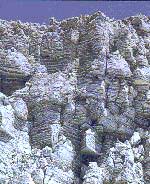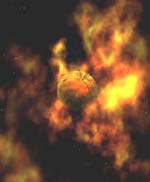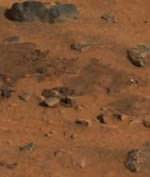
New research from astrobiologists suggests that some of the building blocks for life could have formed early on in the Earth’s oceans if simple minerals, like borax, were present. A chemical called ribose is a key component of RNA and DNA, which are required by all forms of life on Earth. It was originally thought that ribose was too unstable to form unless it’s kept cold, but the scientists found that it could bond to various chemicals, in borate and remain usable.
Astrobiologists, supported by NASA, have announced a major advance in understanding how life may have originated on Earth billions of years ago.
A team of scientists report in the January 9 issue of Science that ribose and other simple sugars that are among life’s building blocks could have accumulated in the early Earth’s oceans if simple minerals, such as borax, were present.
Ribose is a key component of ribonucleic acid (RNA). It is also a precursor for deoxyribonucleic acid (DNA). RNA and DNA, together called “nucleic acids”, are required for all known life, where they enable inheritance, genetics, and evolution.
“Many building blocks in biology can be formed without life”, said Steven Benner, Distinguished Professor in the Departments of Chemistry and Anatomy and Cell Biology at the University of Florida, Gainesville, and the leader of the team. “Fifty years ago, Stanley Miller did a famous experiment that generated amino acids by passing electrical sparks through a primitive atmosphere. This was a key step to understanding how proteins might have originated. But without nucleic acids, proteins appeared to be useless, unable to have children,” he said.
For those interested in the origin of life, making RNA and DNA has been the key unsolved problem. This is in large part because ribose, needed to form RNA and DNA, is unstable and easily forms brown tars unless kept cold. “Ribose and electrical sparks are simply not compatible,” Benner said. “We knew that ribose and other sugars decompose easily. This happens in your kitchen when you bake a cake for too long. It turns brown as the sugars decompose to give other things. Eventually, the cake becomes asphalt,” added Benner.
Recognizing ribose had a particular chemical structure that allowed it to bind to borate, Benner added the mineral colemanite. “Colemanite is a mineral containing borate found in Death Valley. Without it, ribose turns into a brown tar. With it, ribose and other sugars emerge as clean products,” Benner said. He then showed that other borate minerals did the same trick, including ulexite and kernite. The latter is more commonly known as borax. Borax is mined in southern California and used in certain detergents to wash clothing.
“This is only one of several steps that must be taken to convert simple organic molecules found in the cosmos to life,” Benner cautioned. “Much work remains to be done. We are just surprised that such a simple idea has gone unexploited for so long,” he added.
“Steve Benner’s clever work has taken us closer to revealing the origin of life on Earth and furthered NASA’s understanding of the potential for life elsewhere in the universe,” said Michael Meyer, Senior Scientist for Astrobiology at NASA Headquarters, Washington.
The NASA Astrobiology Institute supports nodes at universities and non-profit organizations around the United States. Its goal is to understand the origin, evolution, distribution and fate of life in the universe. The Benner group has been a member of the NASA Astrobiology Institute for five years. “Without ongoing, stable support from NASA, this work would not have been possible,” Benner said.
Also contributing to the research were Alison Olcott, an assistant at the Wrigley Institute on Catalina Island, Calif; Alonso Ricardo, a graduate student at the University of Florida; and Dr. Matthew Carrigan, a postdoctoral fellow at the University of Florida.
The National Science Foundation and the Agouron Institute in Pasadena, Calif. have supported this research.
Original Source: NASA News Release







